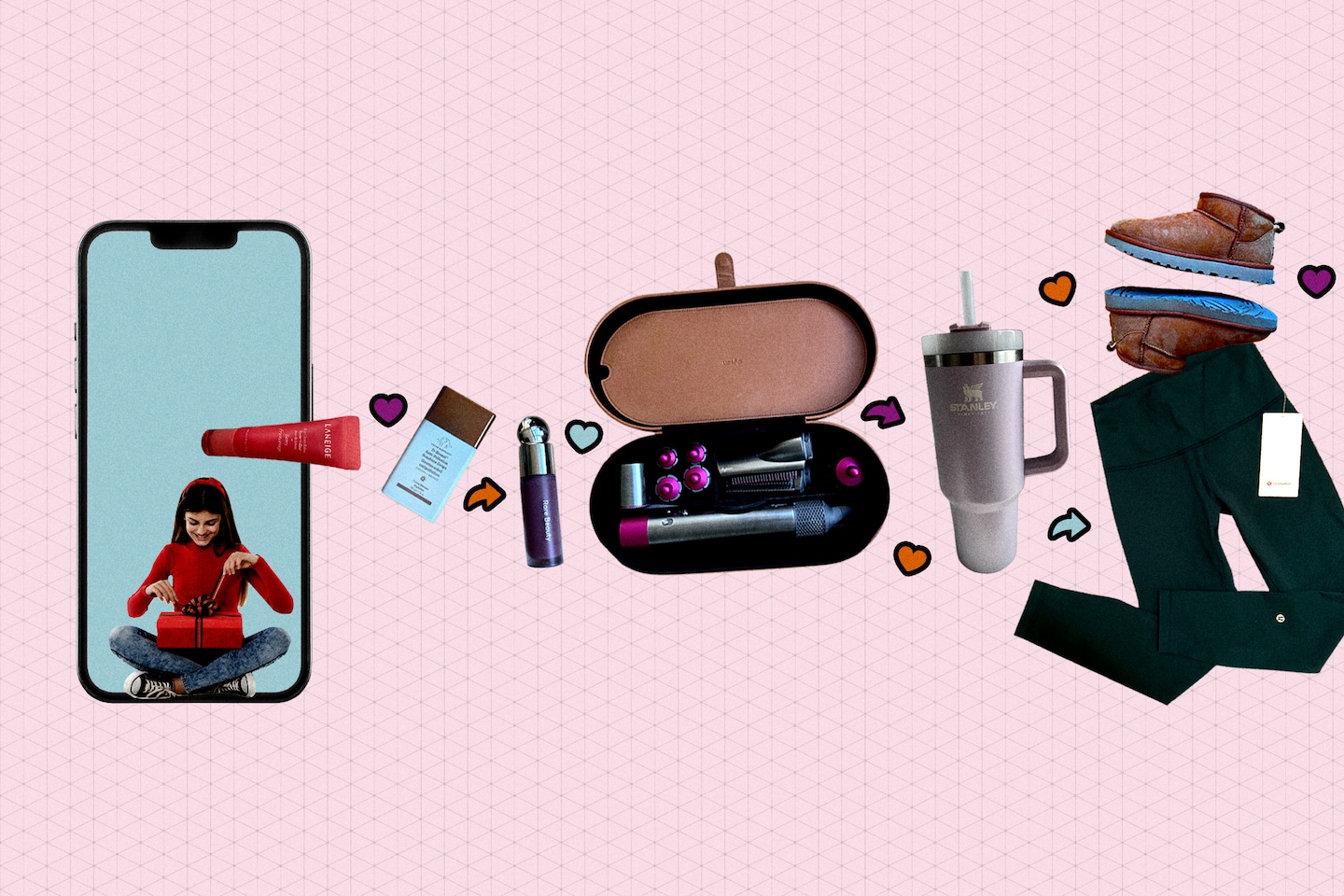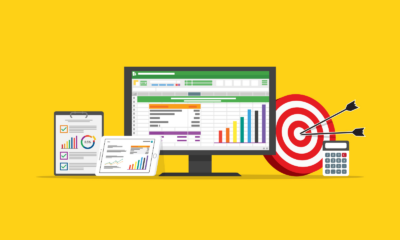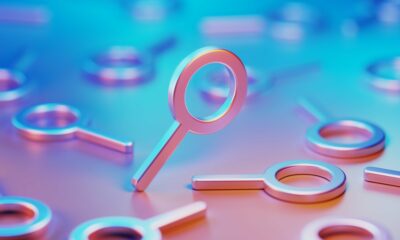Sitting cross-legged on a carpeted floor, the 12-year-old presented her Christmas haul from various relatives on TikTok: Four pairs of shoes (including custom Converse and Mini Uggs), Kendra Scott earrings, a pink Apple Watch, a 40-ounce Stanley tumbler in sage green, and a cache of beauty products from Fenty, Ouai and Summer Fridays, among others.
SOCIAL
Tween trends get more expensive as they take cues from social media

Estimated retail? Roughly $2,200 to check off the most sought-after prizes of an increasingly influential consumer: 10- to 13-year-olds.
The wants of tweens and teens typically come with a certain urgency, as generations of parents can attest. Buttressed by social media, influencer marketing and the “bandwagon effect,” experts say Generation Alpha and younger members of Gen Z have a more prolific and boundless catalogue at their fingertips for what’s “in” than ever before. And their likes are decidedly more upscale: prestige makeup and skin care (and mini fridges to store them), $50 Stanley tumblers, $600 Dyson Airwraps and any number of Apple products.
Though the hyperfocus on trends is typical of the age, it’s more amplified, according to Jenna Drenten, a marketing professor specializing in digital consumer culture at Loyola University Chicago. While earlier generations might have taken their cues from classmates or magazines, tweens and teens now see their peers on platforms like TikTok, Pinterest, Instagram and YouTube.
“It’s sort of teen life on steroids,” she said.
And it’s spawning viral moments in retail, as evidenced by last week’s release of limited-edition Stanley tumblers at Target. Fans lined up outside stores before sunrise to nab the cup made in collaboration with Starbucks, and arguments broke out at a handful of locations. The same thing happened weeks earlier when Target dropped its exclusive Valentine’s Day edition cup.
Stanley is the brand of the moment in the fast-growing category: Sales of insulated stainless steel tumblers, mugs and cups swelled to $1.8 billion in the first 11 months of 2023, a 33 percent jump year over year, according to Circana. And its Quencher leads the pack in the 40-ounce class, the most popular size.
This age group also is snapping up pricey makeup and skin care, even products usually reserved for “mature” skin. That’s given rise to viral TikToks from exasperated adults. In one post with more than 18 million views, influencer and college student Gianna Caldera recounts how a 10-year-old tried bartering after they both reached for the same $38 Drunk Elephant bronzing drops (a rare find in stores these days).
The girl, after giving Caldera “the nastiest up-and-down look I’ve ever gotten in my life,” then responded, “Give me your Gucci heart ring and I will.”
“Is every 10-year-old negotiating in Sephora?” Caldera, 18, asked.
The mania behind these products is heightened by their collectability and the sense of connection they offer, industry experts say.
“Material things have always been markers of identity,” Drenten said.
It’s also compounded by biology — puberty and cognitive development can feel upending and confusing, said Mindy Weinstein, the founder and chief executive of digital marketing company Market MindShift. So buying into a trend or product — perhaps popularized by older teens — can ease those uncomfortable feelings.
It’s known as the “bandwagon effect, and it’s really pronounced in that age group,” said Weinstein, who has a Ph.D in psychology. At that age, “they aren’t always sure where they fit into the world. But now by buying that [item] they feel like they fit in.”
Every generation of tween has had products, accessories, brands and styles they covet. A decade ago, it was Justice clothing, colorful iPod minis, Sidekick cellphones and EOS lip balm. In the early 2000s, Juicy sweatsuits, North Face fleece jackets, Nike Shox, Abercrombie & Fitch and Razr flip phones reigned. In the ’90s it was buying from the Delia’s catalogue magazine, Lip Smacker balms, United Colors of Benetton and Tommy Hilfiger polos. The ’80s had Guess jeans, Keds, banana hair clips and J. Crew sweaters. In the ’70s it was mood rings, Wrangler and Levi’s jeans, Puma sneakers and Frye boots.
Social media boosted brands’ visibility, in part because they send products to influencers of all ages, encouraging them to use or show off the items in videos.
Ava McGowan, a 13-year-old from Virginia Beach, said she goes to TikTok and Instagram to find new products. “I like to see what people use and how it works,” she said.
More than half of U.S. teenagers (ages 13 to 19) spend at least four hours a day on social media, according to Gallup, and most of that time is spent on YouTube and TikTok. The constant push of products by influencers or their peers on their screens blurs the line between luxury and necessity, and suddenly that $50 intensive hydration serum, $300 gaming chair or pair of $160 Ultra Mini Platform Uggs is easy to justify.
And it’s highly effective — consumers are more likely to consider buying a product and have a favorable opinion about it if it went viral, said Ellyn Briggs, a brands analyst at Morning Consult. So, it’s no coincidence that some of the top items on tweens’ Christmas lists included viral favorites like Lululemon, Stanley and Sol de Janeiro fragrances.
“TikTok influencers already have their trust … teens and tweens see them and they want to also be into that trend and feel like they’re belonging to that social group,” Weinstein said.
It used to be that our hair, makeup and skin care products were only visible to those who entered our bedrooms, scanning vanities and opening drawers. Now, teens and tweens are filming “Get ready with me” videos, showing off their Rare Beauty liquid blush ($23), Laneige lip balm ($18) and Charlotte Tilbury setting spray ($38) as they complain about school or recap a friend’s bat mitzvah.
Margeaux Richmond and her friends spend a lot of time talking about skin care. The 12-year-old from Des Moines said she got a $62 Drunk Elephant moisturizer for Christmas. “It’s kind of pricey, but if it’s good for your skin it’s worth it,” she said. “It’s kind of important to me and my friends because we don’t want our skin to look bad or anything.”
Brands are uniquely tapped in to what consumers want. They can interact with customers in the comments on TikTok, gain instant feedback and track what’s trending. Briggs pointed to colors as an example. Younger consumers — particularly female — are attracted to bright hues and pastels, she said, noting that Stanley looks to beauty and fashion trends for its tumbler palette.
This also fuels a collectability culture. The customer no longer wants one water bottle, one pair of Air Jordans, one Summer Fridays lip balm or one Nike sweatshirt — they want them in every color.
“We have to think about today’s consumers, not as consumers, but as fans; and fandom has always been intertwined with collecting,” Drenten said. “In today’s culture, particularly among young people, we’ve kind of shifted away from obsession with celebrities to obsession with brands.”
Having and displaying a collection on shelves and on social media is seen as a status symbol. Superfans also collect accessories for some of these products, Briggs said, spawning a whole side industry for some products. People are buying sweaters, straw-toppers and decorations for their Stanleys and matching accessories for popular athleisure wear.
Who’s doing the actual buying is harder to track. Not all adolescents have jobs or parents who are able or willing to spend $550 on Apple AirPods Max or $275 on a Tiffany & Co’s Pink Double Heart Tag Pendant necklace. “These products, to some extent, are a point of privilege and status,” Drenten said.
Some of the spending could be attributed to more young people in the workforce: Roughly 37 percent of 16- to 19-year-olds had a job or were looking for one last year, according to the U.S. Bureau of Labor Statistics. That’s the highest rate since 2009.
Richmond said she uses her babysitting money to buy Drunk Elephant skin care or Kendra Scott jewelry — items “my parents won’t buy me.” She’s saving up for her second Stanley tumbler. McGowan often uses gift cards and cash from holidays or birthdays, though sometimes her parents will pay. But she doesn’t splurge too often because she knows her favorite brands are spendy: “I usually only buy it if I really need it.”
Drenten emphasized that shopping or gift hauls on social media don’t reflect what every teen or tween wants. It varies by socioeconomics, demographics and personal preference. “At the end of the day, they can still be influenced by who they’re around and not necessarily what they’re seeing as the top line products online.”
A side note to this phenomenon: The same willingness to try new products and brands because of what they see on social media also means Gen Z and Gen Alpha are more fickle when it comes to brand loyalty, Briggs said. It’s inevitable that Stanley will be replaced by another water bottle in the near future (after all, it usurped Hydro Flask, which overtook S’well, which bumped YETI, which displaced CamelBak, which ousted Nalgene).
Plus, once tweens jump on a trend, the “older kids, teenagers, young 20s adults, kind of separate.”
SOCIAL
12 Proven Methods to Make Money Blogging in 2024

 This is a contributed article.
This is a contributed article.
The world of blogging continues to thrive in 2024, offering a compelling avenue for creative minds to share their knowledge, build an audience, and even turn their passion into profit. Whether you’re a seasoned blogger or just starting, there are numerous effective strategies to monetize your blog and achieve financial success. Here, we delve into 12 proven methods to make money blogging in 2024:
1. Embrace Niche Expertise:
Standing out in the vast blogosphere requires focus. Carving a niche allows you to cater to a specific audience with targeted content. This not only builds a loyal following but also positions you as an authority in your chosen field. Whether it’s gardening techniques, travel hacking tips, or the intricacies of cryptocurrency, delve deep into a subject you’re passionate and knowledgeable about. Targeted audiences are more receptive to monetization efforts, making them ideal for success.
2. Content is King (and Queen):
High-quality content remains the cornerstone of any successful blog. In 2024, readers crave informative, engaging, and well-written content that solves their problems, answers their questions, or entertains them. Invest time in crafting valuable blog posts, articles, or videos that resonate with your target audience.
- Focus on evergreen content: Create content that remains relevant for a long time, attracting consistent traffic and boosting your earning potential.
- Incorporate multimedia: Spice up your content with captivating images, infographics, or even videos to enhance reader engagement and improve SEO.
- Maintain consistency: Develop a regular publishing schedule to build anticipation and keep your audience coming back for more.
3. The Power of SEO:
Search Engine Optimization (SEO) ensures your blog ranks high in search engine results for relevant keywords. This increases organic traffic, the lifeblood of any monetization strategy.
- Keyword research: Use keyword research tools to identify terms your target audience searches for. Strategically incorporate these keywords into your content naturally.
- Technical SEO: Optimize your blog’s loading speed, mobile responsiveness, and overall technical aspects to improve search engine ranking.
- Backlink building: Encourage other websites to link back to your content, boosting your blog’s authority in the eyes of search engines.
4. Monetization Magic: Affiliate Marketing
Affiliate marketing allows you to earn commissions by promoting other companies’ products or services. When a reader clicks on your affiliate link and makes a purchase, you get a commission.
- Choose relevant affiliates: Promote products or services that align with your niche and resonate with your audience.
- Transparency is key: Disclose your affiliate relationships clearly to your readers and build trust.
- Integrate strategically: Don’t just bombard readers with links. Weave affiliate promotions naturally into your content, highlighting the value proposition.
5. Display Advertising: A Classic Approach
Display advertising involves placing banner ads, text ads, or other visual elements on your blog. When a reader clicks on an ad, you earn revenue.
- Choose reputable ad networks: Partner with established ad networks that offer competitive rates and relevant ads for your audience.
- Strategic ad placement: Place ads thoughtfully, avoiding an overwhelming experience for readers.
- Track your performance: Monitor ad clicks and conversions to measure the effectiveness of your ad placements and optimize for better results.
6. Offer Premium Content:
Providing exclusive, in-depth content behind a paywall can generate additional income. This could be premium blog posts, ebooks, online courses, or webinars.
- Deliver exceptional value: Ensure your premium content offers significant value that justifies the price tag.
- Multiple pricing options: Consider offering tiered subscription plans to cater to different audience needs and budgets.
- Promote effectively: Highlight the benefits of your premium content and encourage readers to subscribe.
7. Coaching and Consulting:
Leverage your expertise by offering coaching or consulting services related to your niche. Readers who find your content valuable may be interested in personalized guidance.
- Position yourself as an expert: Showcase your qualifications, experience, and client testimonials to build trust and establish your credibility.
- Offer free consultations: Provide a limited free consultation to potential clients, allowing them to experience your expertise firsthand.
- Develop clear packages: Outline different coaching or consulting packages with varying time commitments and pricing structures.
8. The Power of Community: Online Events and Webinars
Host online events or webinars related to your niche. These events offer valuable content while also providing an opportunity to promote other monetization avenues.
- Interactive and engaging: Structure your online events to be interactive with polls, Q&A sessions, or live chats. Click here to learn more about image marketing with Q&A sessions and live chats.
9. Embrace the Power of Email Marketing:
Building an email list allows you to foster stronger relationships with your audience and promote your content and offerings directly.
- Offer valuable incentives: Encourage readers to subscribe by offering exclusive content, discounts, or early access to new products.
- Segmentation is key: Segment your email list based on reader interests to send targeted campaigns that resonate more effectively.
- Regular communication: Maintain consistent communication with your subscribers through engaging newsletters or updates.
10. Sell Your Own Products:
Take your expertise to the next level by creating and selling your own products. This could be physical merchandise, digital downloads, or even printables related to your niche.
- Identify audience needs: Develop products that address the specific needs and desires of your target audience.
- High-quality offerings: Invest in creating high-quality products that offer exceptional value and user experience.
- Utilize multiple platforms: Sell your products through your blog, online marketplaces, or even social media platforms.
11. Sponsorships and Brand Collaborations:
Partner with brands or businesses relevant to your niche for sponsored content or collaborations. This can be a lucrative way to leverage your audience and generate income.
- Maintain editorial control: While working with sponsors, ensure you retain editorial control to maintain your blog’s authenticity and audience trust.
- Disclosures are essential: Clearly disclose sponsored content to readers, upholding transparency and ethical practices.
- Align with your niche: Partner with brands that complement your content and resonate with your audience.
12. Freelancing and Paid Writing Opportunities:
Your blog can serve as a springboard for freelance writing opportunities. Showcase your writing skills and expertise through your blog content, attracting potential clients.
- Target relevant publications: Identify online publications, websites, or magazines related to your niche and pitch your writing services.
- High-quality samples: Include high-quality blog posts from your site as writing samples when pitching to potential clients.
- Develop strong writing skills: Continuously hone your writing skills and stay updated on current trends in your niche to deliver exceptional work.
Conclusion:
Building a successful blog that generates income requires dedication, strategic planning, and high-quality content. In today’s digital age, there are numerous opportunities to make money online through blogging. By utilizing a combination of methods such as affiliate marketing, sponsored content, and selling digital products or services, you can leverage your blog’s potential and achieve financial success.
Remember, consistency in posting, engaging with your audience, and staying adaptable to trends are key to thriving in the ever-evolving blogosphere. Embrace new strategies, refine your approaches, and always keep your readers at the forefront of your content creation journey. With dedication and the right approach, your blog has the potential to become a valuable source of income and a platform for sharing your knowledge and passion with the world, making money online while doing what you love.
Image Credit: DepositPhotos
SOCIAL
Snapchat Explores New Messaging Retention Feature: A Game-Changer or Risky Move?

In a recent announcement, Snapchat revealed a groundbreaking update that challenges its traditional design ethos. The platform is experimenting with an option that allows users to defy the 24-hour auto-delete rule, a feature synonymous with Snapchat’s ephemeral messaging model.
The proposed change aims to introduce a “Never delete” option in messaging retention settings, aligning Snapchat more closely with conventional messaging apps. While this move may blur Snapchat’s distinctive selling point, Snap appears convinced of its necessity.
According to Snap, the decision stems from user feedback and a commitment to innovation based on user needs. The company aims to provide greater flexibility and control over conversations, catering to the preferences of its community.
Currently undergoing trials in select markets, the new feature empowers users to adjust retention settings on a conversation-by-conversation basis. Flexibility remains paramount, with participants able to modify settings within chats and receive in-chat notifications to ensure transparency.
Snapchat underscores that the default auto-delete feature will persist, reinforcing its design philosophy centered on ephemerality. However, with the app gaining traction as a primary messaging platform, the option offers users a means to preserve longer chat histories.
The update marks a pivotal moment for Snapchat, renowned for its disappearing message premise, especially popular among younger demographics. Retaining this focus has been pivotal to Snapchat’s identity, but the shift suggests a broader strategy aimed at diversifying its user base.
This strategy may appeal particularly to older demographics, potentially extending Snapchat’s relevance as users age. By emulating features of conventional messaging platforms, Snapchat seeks to enhance its appeal and broaden its reach.
Yet, the introduction of message retention poses questions about Snapchat’s uniqueness. While addressing user demands, the risk of diluting Snapchat’s distinctiveness looms large.
As Snapchat ventures into uncharted territory, the outcome of this experiment remains uncertain. Will message retention propel Snapchat to new heights, or will it compromise the platform’s uniqueness?
Only time will tell.
SOCIAL
Catering to specific audience boosts your business, says accountant turned coach

While it is tempting to try to appeal to a broad audience, the founder of alcohol-free coaching service Just the Tonic, Sandra Parker, believes the best thing you can do for your business is focus on your niche. Here’s how she did just that.
When running a business, reaching out to as many clients as possible can be tempting. But it also risks making your marketing “too generic,” warns Sandra Parker, the founder of Just The Tonic Coaching.
“From the very start of my business, I knew exactly who I could help and who I couldn’t,” Parker told My Biggest Lessons.
Parker struggled with alcohol dependence as a young professional. Today, her business targets high-achieving individuals who face challenges similar to those she had early in her career.
“I understand their frustrations, I understand their fears, and I understand their coping mechanisms and the stories they’re telling themselves,” Parker said. “Because of that, I’m able to market very effectively, to speak in a language that they understand, and am able to reach them.”Â
“I believe that it’s really important that you know exactly who your customer or your client is, and you target them, and you resist the temptation to make your marketing too generic to try and reach everyone,” she explained.
“If you speak specifically to your target clients, you will reach them, and I believe that’s the way that you’re going to be more successful.
Watch the video for more of Sandra Parker’s biggest lessons.
-

 PPC7 days ago
PPC7 days agoHow the TikTok Algorithm Works in 2024 (+9 Ways to Go Viral)
-

 SEO6 days ago
SEO6 days agoHow to Use Keywords for SEO: The Complete Beginner’s Guide
-

 MARKETING7 days ago
MARKETING7 days agoHow To Protect Your People and Brand
-

 MARKETING4 days ago
MARKETING4 days agoAdvertising on Hulu: Ad Formats, Examples & Tips
-

 MARKETING5 days ago
MARKETING5 days agoUpdates to data build service for better developer experiences
-

 SEO7 days ago
SEO7 days agoAutomate Multi-Site Reporting With Google Sheets And GSC API
-

 MARKETING1 day ago
MARKETING1 day ago18 Events and Conferences for Black Entrepreneurs in 2024
-

 MARKETING6 days ago
MARKETING6 days agoThe Ultimate Guide to Email Marketing













